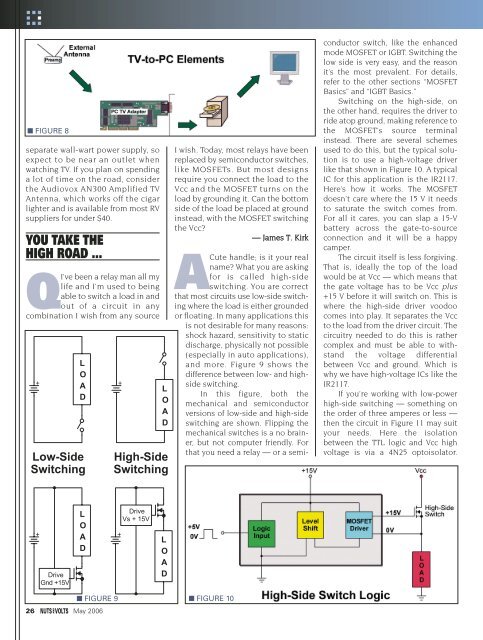Create successful ePaper yourself
Turn your PDF publications into a flip-book with our unique Google optimized e-Paper software.
■ FIGURE 8separate wall-wart power supply, soexpect to be near an outlet whenwatching TV. If you plan on spendinga lot of time on the road, considerthe Audiovox AN300 Amplified TVAntenna, which works off the cigarlighter and is available from most RVsuppliers for under $40.YOU TAKE THEHIGH ROAD ...QI’ve been a relay man all mylife and I’m used to beingable to switch a load in andout of a circuit in anycombination I wish from any source+LOADLow-SideSwitching+LOADHigh-SideSwitchingI wish. Today, most relays have beenreplaced by semiconductor switches,like MOSFETs. But most designsrequire you connect the load to theVcc and the MOSFET turns on theload by grounding it. Can the bottomside of the load be placed at groundinstead, with the MOSFET switchingthe Vcc?— James T. KirkACute handle; is it your realname? What you are askingfor is called high-sideswitching. You are correctthat most circuits use low-side switchingwhere the load is either groundedor floating. In many applications thisis not desirable for many reasons:shock hazard, sensitivity to staticdischarge, physically not possible(especially in auto applications),and more. Figure 9 shows thedifference between low- and highsideswitching.In this figure, both themechanical and semiconductorversions of low-side and high-sideswitching are shown. Flipping themechanical switches is a no brainer,but not computer friendly. Forthat you need a relay — or a semiconductorswitch, like the enhancedmode MOSFET or IGBT. Switching thelow side is very easy, and the reasonit’s the most prevalent. For details,refer to the other sections “MOSFETBasics” and “IGBT Basics.”Switching on the high-side, onthe other hand, requires the driver toride atop ground, making reference tothe MOSFET’s source terminalinstead. There are several schemesused to do this, but the typical solutionis to use a high-voltage driverlike that shown in Figure 10. A typicalIC for this application is the IR2117.Here’s how it works. The MOSFETdoesn’t care where the 15 V it needsto saturate the switch comes from.For all it cares, you can slap a 15-Vbattery across the gate-to-sourceconnection and it will be a happycamper.The circuit itself is less forgiving.That is, ideally the top of the loadwould be at Vcc — which means thatthe gate voltage has to be Vcc plus+15 V before it will switch on. This iswhere the high-side driver voodoocomes into play. It separates the Vccto the load from the driver circuit. Thecircuitry needed to do this is rathercomplex and must be able to withstandthe voltage differentialbetween Vcc and ground. Which iswhy we have high-voltage ICs like theIR2117.If you’re working with low-powerhigh-side switching — something onthe order of three amperes or less —then the circuit in Figure 11 may suityour needs. Here the isolationbetween the TTL logic and Vcc highvoltage is via a 4N25 optoisolator.DriveLVs + 15VO+ A +DDriveGnd +15VLOAD■ FIGURE 926 May 2006■ FIGURE 10
















